- in langai by Administratorius
Fix Windows Modules Installer Worker High CPU Usage
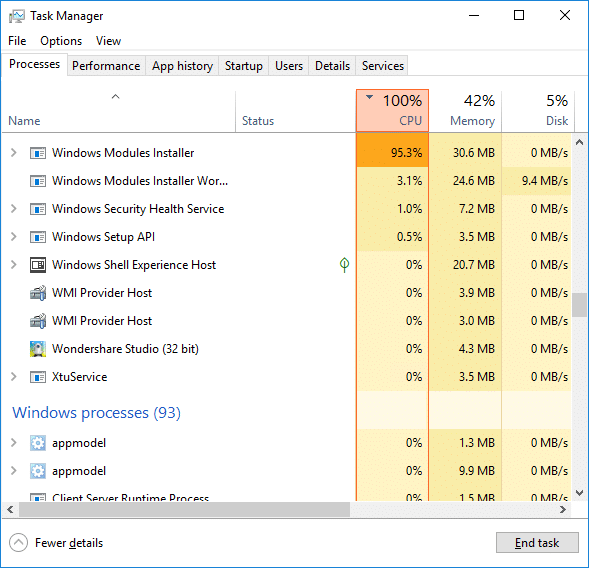
If you are facing the High CPU Usage by Windows Modules Installer Worker, then don’t worry as thousands of other users are also facing the similar problem and therefore, there are many working fixes which we will be discussing today in this article. To verify if you are facing this issue open Task Manager (Ctrl + Shift + Esc) and you will find that the Windows Modules Installer Worker is consuming High CPU or Disk Usage.

Pro Patarimas: You may leave your PC overnight or for a few hours to see the issue rectify itself once the Windows is finished downloading and installing updates.
What is Windows Modules Installer worker (WMIW)?
Windows Modules Installer worker (WMIW) is a service which takes cares of automatically installing Windows Update. According to its service description, WMIW is a system process that enables automatic installation, modification, and removal of Windows updates and optional components.
This process is responsible for finding new Windows Update automatically and installing them. As you might be aware that Windows 10 automatically install newer builds (i.e. 1803 etc.) via Windows Updates, so this process is responsible for installing these updates in the background.
Although this process is called Windows Modules Installer worker (WMIW) and you will see the same name in the Processes tab in the Task Manager, but if you switch to Details tab, then you will find the name of the file as TiWorker.exe.
Why Is Windows Modules Installer worker Using So Much CPU?
As Windows Modules Installer worker (TiWorker.exe) runs continuously in the background, sometimes it might utilize high CPU or disk usage when installing or uninstalling Windows Updates. But if its constantly using high CPU then the Windows Modules Installer worker may have become unresponsive while checking new updates. As a result, you may be experiencing lags, or your system might hang or freeze completely.
The first thing users do when they experience freezing, or lagging issues on their system is to restart their PC, but I assure you that this strategy won’t work in this case. This is because the issue will not resolve by itself until and unless you fix the underlying cause.
Fix Windows Modules Installer Worker High CPU Usage
Būtinai sukurkite atkūrimo tašką, jei kas nors nutiktų.
Windows Modules Installer Worker (WMIW) is an important service, and it should not be disabled. WMIW or TiWorker.exe is not a virus or malware, and you cannot just delete this service from your PC. So without wasting any time let’s see How to Fix Windows Modules Installer Worker High CPU Usage naudodamiesi toliau pateiktu trikčių šalinimo vadovu.
1 būdas: paleiskite „Windows Update“ trikčių šalinimo įrankį
1. Norėdami atidaryti, paspauskite „Windows“ klavišą + I Nustatymai tada spustelėkite Atnaujinimo ir saugos piktograma.
![]()
2. Kairiajame meniu pasirinkite Šalinti pagal "Pakilti ir veikti" spustelėkite "Windows" naujinimas.

3. Dabar spustelėkite „Paleiskite trikčių šalinimo įrankį” under Windows Update.
4. Let the troubleshooter run, and it will automatically fix any issues found with Windows Update taking forever.
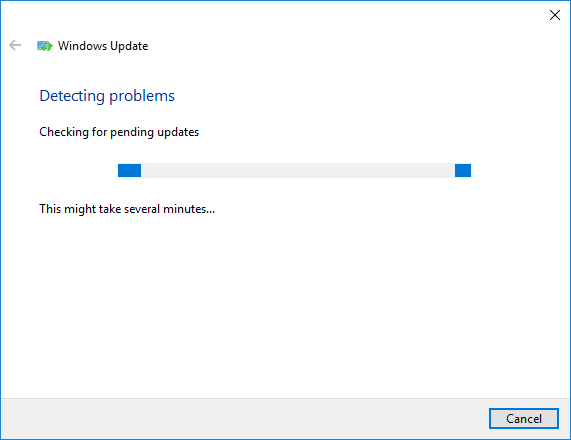
Method 2: Manually Check for Windows Updates
1. Paspauskite Windows klavišą + I, tada pasirinkite Atnaujinimas ir sauga.
2. Kairėje pusėje paspaudžiamas meniu "Windows" naujinimas.
3. Dabar spustelėkite „Patikrinti atnaujinimus“ mygtuką, kad patikrintumėte, ar nėra galimų naujinimų.

4. Jei laukiama atnaujinimų, spustelėkite Atsisiųskite ir įdiekite naujinimus.

5. Atsisiuntę naujinimus įdiekite juos ir jūsų „Windows“ bus atnaujinta.
Method 3: Configure Windows Update to Manual
Atsargiai: This method will switch Windows Update from automatically installing the new updates to the manual. This means you have to manually check for Windows Update (weekly or monthly) to keep your PC secure. But follow this method, and you can again set the Updates to Automatic once the issue is resolved.
1. Paspauskite „Windows“ klavišą + R, tada įveskite services.msc ir paspauskite "Enter".

2. Slinkite žemyn ir raskite "Windows Installer" moduliai service in the list.
3. Dešiniuoju pelės mygtuku spustelėkite „Windows“ modulių diegimo programa ir pasirinkite Savybės
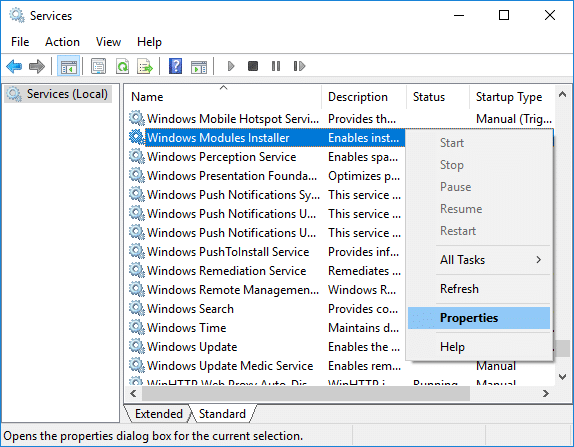
4. Dabar spustelėkite Stop then from the Paleisties tipas drop-down select Rankinis.
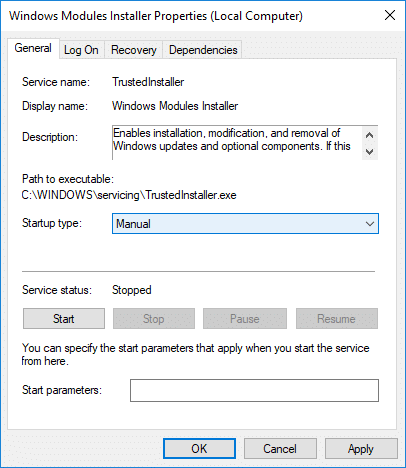
5. Spustelėkite Apply, tada spustelėkite Gerai.
6. Similarly, follow the same step for the Windows Update service.

7. Iš naujo paleiskite kompiuterį, kad išsaugotumėte pakeitimus.
8. Vėl patikrinti Windows Updates Manually ir įdiekite visus laukiančius naujinimus.
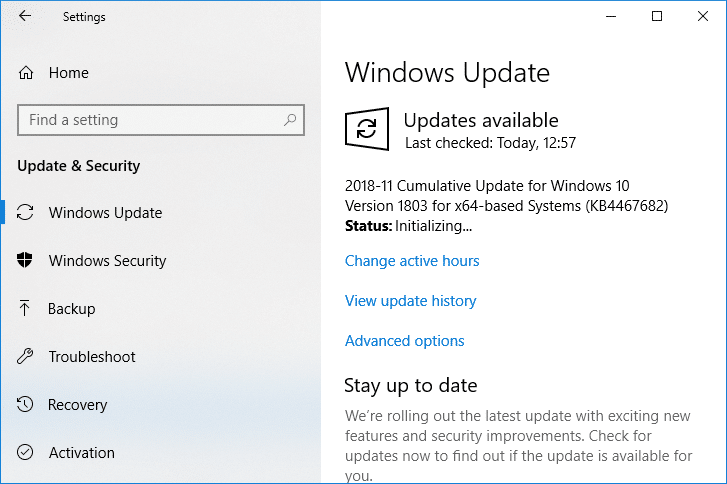
9. Once is done, again go back to services.msc window and open the Windows Modules Installer & Windows Update Properties langas.
10. Nustatykite Paleisties tipas į Automatinis ir spauskite pradžia. Then click Apply followed by OK.
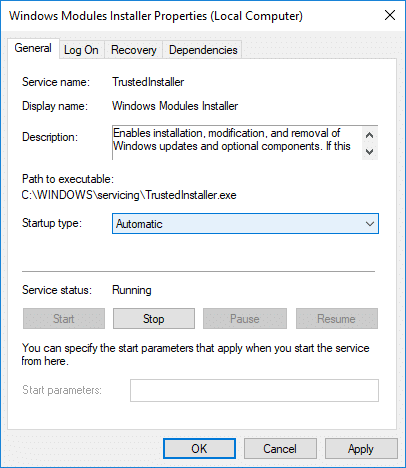
11. Iš naujo paleiskite kompiuterį, kad išsaugotumėte pakeitimus.
4 būdas: paleiskite sistemos priežiūros trikčių šalinimo įrankį
1. Paspauskite Windows klavišą + R, tada įveskite control ir paspauskite Enter, kad atidarytumėte Valdymo skydas.

2. Ieškokite Trikčių šalinimas ir spustelėkite Problemų sprendimas.

3. Tada spustelėkite Rodyti visus kairiojoje srityje.
4. Spauskite ant “System Maintenance” paleisti System Maintenance Troubleshooter.

5. Trikčių šalinimo įrankis gali tai padaryti Fix Windows Modules Installer Worker High CPU Usage, but if it didn’t, then you need to run System Performance Troubleshooter.
6. Atidarykite komandų eilutę. Vartotojas gali atlikti šį veiksmą ieškodamas „cmd“ Ir tada paspauskite "Enter".

7. Įveskite šią komandą į cmd ir paspauskite Enter:
msdt.exe / id PerformanceDiagnostic
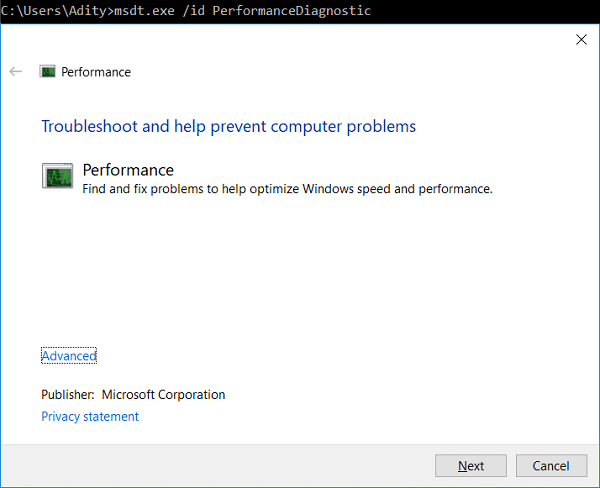
8. Follow the on-screen instruction to run the troubleshooter and fix any issues find the System.
9. Finally, exit the cmd and reboot your PC.
Method 5: Disable Automatic Maintenance
Sometimes Automatic Maintenance can conflict with the Windows Modules Installer Worker service, so try to disable Automatic Maintenance using this guide and see if this fixes your issue.
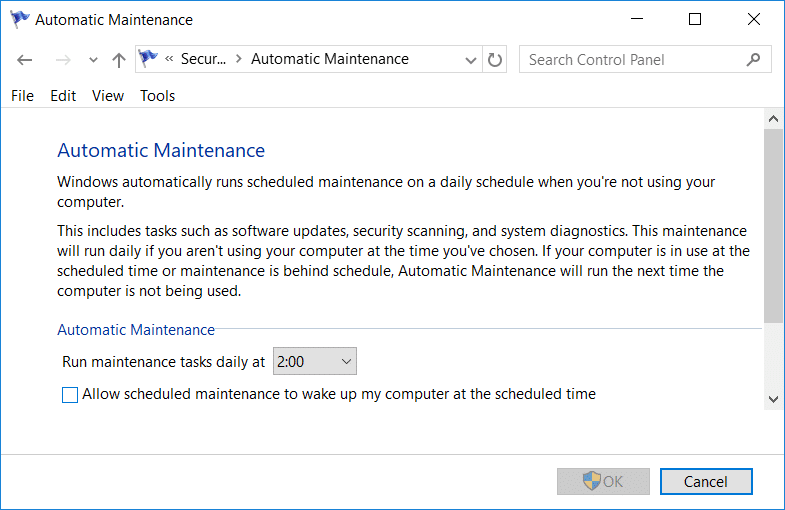
Although disabling Automatic Maintenance is not a good idea, but there might be some case where you need to actually disable it, for example, if your PC freezes during automatic maintenance or Windows Modules Installer Worker High CPU Usage issue then you should disable maintenance to troubleshoot the issue.
Method 6: Run System File Checker and DISM
1. Atidarykite komandų eilutę. Vartotojas gali atlikti šį veiksmą ieškodamas „cmd“ Ir tada paspauskite "Enter".
2. Dabar į cmd įveskite šią informaciją ir paspauskite Enter:
Sfc /scannow sfc /scannow /offbootdir=c: /offwindir=c:windows (jei aukščiau aprašyta nepavyksta, pabandykite šį)

3. Palaukite, kol baigsis aukščiau nurodytas procesas, ir atlikę iš naujo paleiskite kompiuterį.
4. Dar kartą atidarykite cmd ir įveskite šią komandą ir po kiekvienos paspauskite Enter:
Dism /Prisijungus /Cleanup-Image /CheckHealth Dism /Prisijungus /Cleanup-Image /ScanHealth Dism /Prisijungus /Cleanup-Image /RestoreHealth

5. Leiskite vykdyti komandą DISM ir palaukite, kol ji baigsis.
6. Jei aukščiau pateikta komanda neveikia, išbandykite toliau pateiktą:
Dism /Image:C:offline /Cleanup-Image /RestoreHealth /Šaltinis:c:testmountwindows Dism /Online /Cleanup-Image /RestoreHealth /Šaltinis:c:testmountwindows /LimitAccess
Pastaba: Pakeiskite C:RepairSourceWindows savo taisymo šaltiniu („Windows“ diegimo arba atkūrimo disku).
7. Iš naujo paleiskite kompiuterį, kad išsaugotumėte pakeitimus ir patikrintumėte, ar galite tai padaryti Fix Windows Modules Installer Worker High CPU Usage.
7 būdas: atlikite švarų paleidimą
Sometimes 3rd party software can conflict with Windows and can cause the issue. To Fix Windows Modules Installer Worker High CPU Usage issue, turite atlikti švarų kompiuterio paleidimą ir žingsnis po žingsnio diagnozuoti problemą.
Method 8: Set your WiFi as Metered Connection
Pastaba: This will stop Windows Automatic Update, and you will need to manually check for Updates.
1. Norėdami atidaryti, paspauskite „Windows“ klavišą + I Nustatymai tada spustelėkite Tinklas ir internetas.

2. Kairiajame meniu pasirinkite Wi-Fi.
3. Under Wi-Fi, spragtelėjimas jūsų šiuo metu connected network (WiFi).
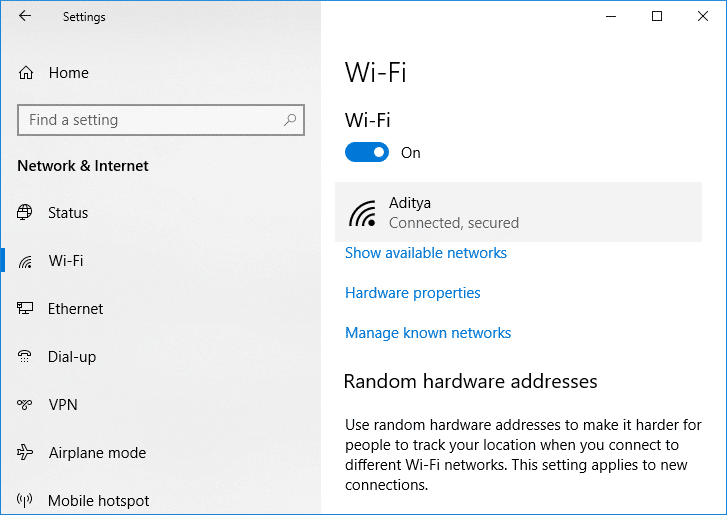
4. Scroll down to Metered connection and įjungti perjungimą pagal "Nustatytas kaip matavimo jungtis".
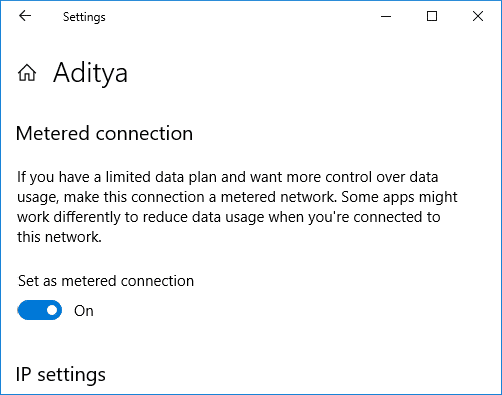
5. Close Settings and reboot your PC to save changes.
Rekomenduojama:
Tai viskas, jums pavyko Fix Windows Modules Installer Worker High CPU Usage bet jei vis dar turite klausimų dėl šios pamokos, nedvejodami paklauskite jų komentarų skiltyje.
